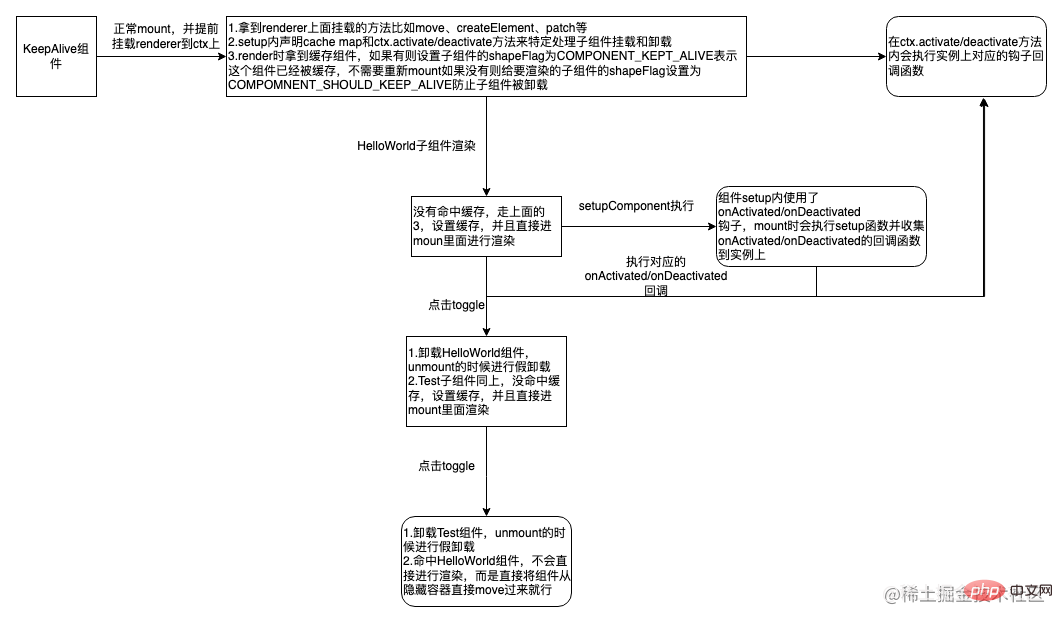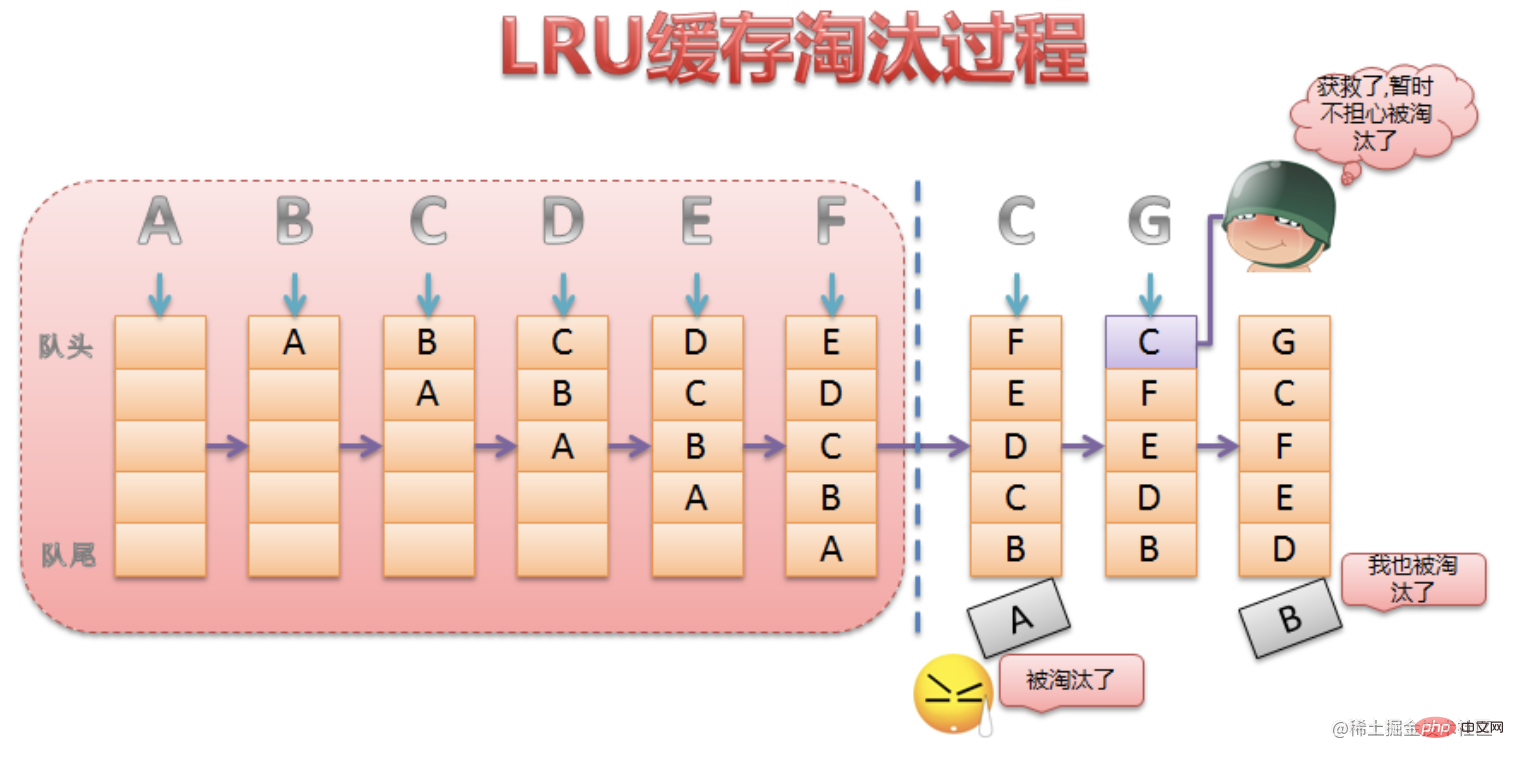Vue の KeepAlive コンポーネントについて説明する記事

最近、Vue 関連のナレッジポイントを調べていたところ、KeepAlive コンポーネントを見て、コンポーネント間の切り替え時に再レンダリングが行われない仕組みに興味があったので、もっと詳しく見てみましょう。 (学習ビデオ共有: vue ビデオ チュートリアル)
特定の内部実装がどのように実装されているかを知りたい場合、またはある程度の理解はあるものの十分に詳しくない場合は、次のことができます。
ヒントの統合: このようにして、面接中にこの知識ポイントについて他の人に大声で質問できますか?
KeepAlive とは
<keepalive></keepalive> は組み込みコンポーネントであり、その機能は 複数のコンポーネント間を動的に切り替えることです。 いつキャッシュ削除されたコンポーネント インスタンス。
KeepAlive 関数
KeepAlive という言葉は HTTP プロトコルから借用されたものです。HTTP プロトコルでは、KeepAlive は永続接続とも呼ばれます。その機能は複数のリクエストを許可することです。同じ HTTP 接続を共有する /responses により、HTTP 接続の頻繁な破棄と作成によって生じる追加のパフォーマンス オーバーヘッドが解決されます。同様に、Vue の KeepAlive コンポーネントも、 コンポーネントが頻繁に破棄/再構築されることを回避し、 パフォーマンスのオーバーヘッドを回避することを目的としています。
// App.vue <Test :msg="curTab" v-if="curTab === 'Test'"></Test> <HelloWorld :msg="curTab" v-if="curTab === 'HelloWorld'"></HelloWorld> <div @click="toggle">toggle</div>
上記のコードからわかるように、トグルを頻繁にクリックすると、Test/HelloWorld コンポーネントが頻繁にレンダリングされます。ユーザーが頻繁にクリックすると、Test コンポーネントを頻繁に破棄/レンダリングする必要があります。レンダリング時間が長くなり、パフォーマンスが低下します。
したがって、このパフォーマンスのオーバーヘッドを解決するには、KeepAlive コンポーネントをいつ使用するかを知る必要があります。
<KeepAlive> <component :is="curTab === 'Test' ? Test : HelloWorld" :msg="curTab"></component> </KeepAlive> <div @click="toggle">toggle</div>
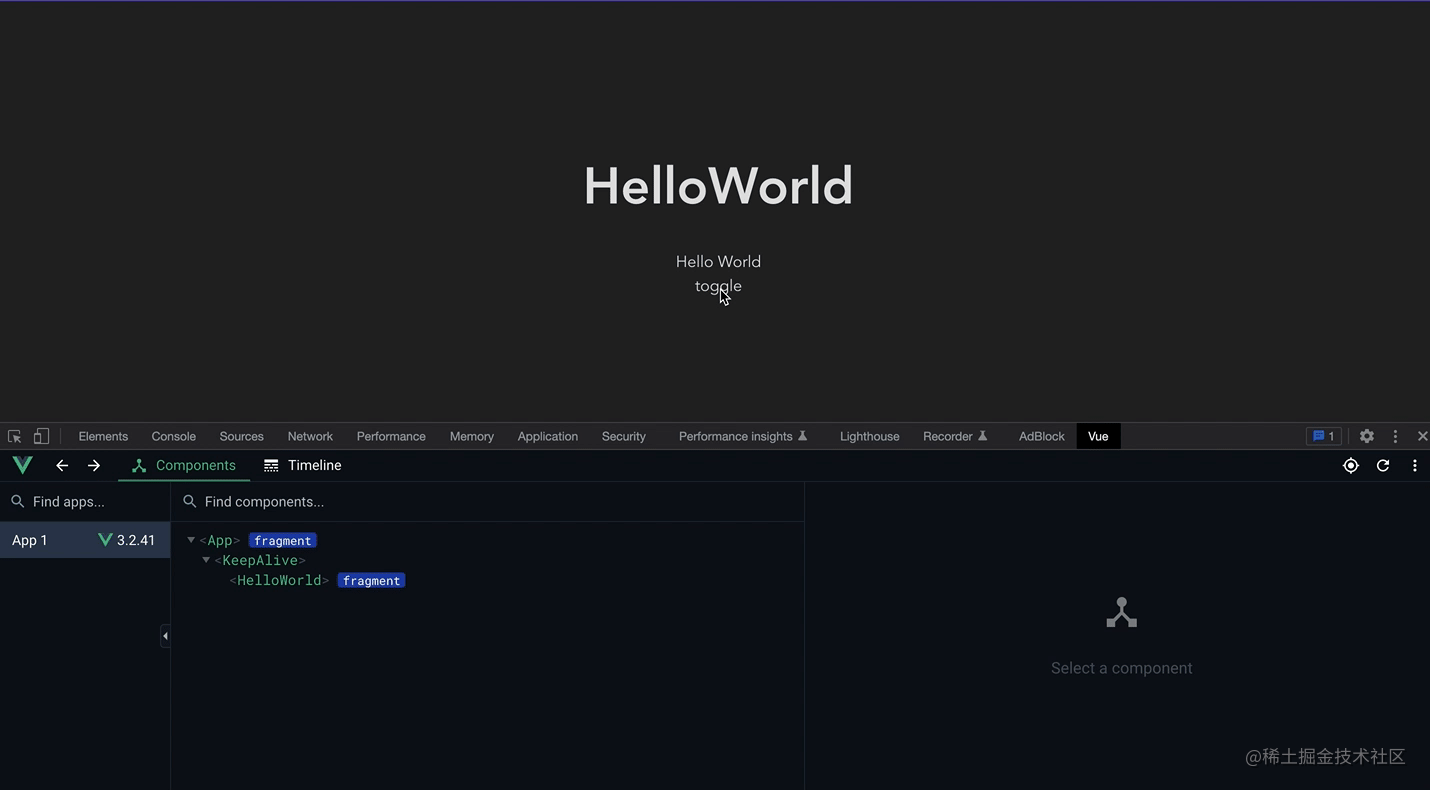
この画面記録を見ることができます。最初のロード後、頻繁に切り替えても破壊されて再マウントされることはなく、コンポーネントが (破壊されるのではなく) 非アクティブ化されるだけです。レンダリングするコンポーネントが大きい場合は、パフォーマンスを最適化できます。
実際に体験してみたい場合は、この例をご覧ください。公式デモでは、データがキャッシュされますが、開発中および使用中に注意する必要があります
実装方法
実装原理は実際には非常に単純で、実際には、キャッシュ管理と特定の破棄およびレンダリング ロジックです。他のコンポーネントとは異なります。
KeepAlive コンポーネントは、コンポーネントを アンインストールするときに実際にアンインストールすることはできませんが、非表示のコンテナ に配置し、アクティブ化されると 非表示のコンテナからコンポーネントを削除します。それを取り出して、これを実際の dom にマウントします。これは、KeepAlive activated と deactivated の 2 つの固有のライフ サイクルに対応します。
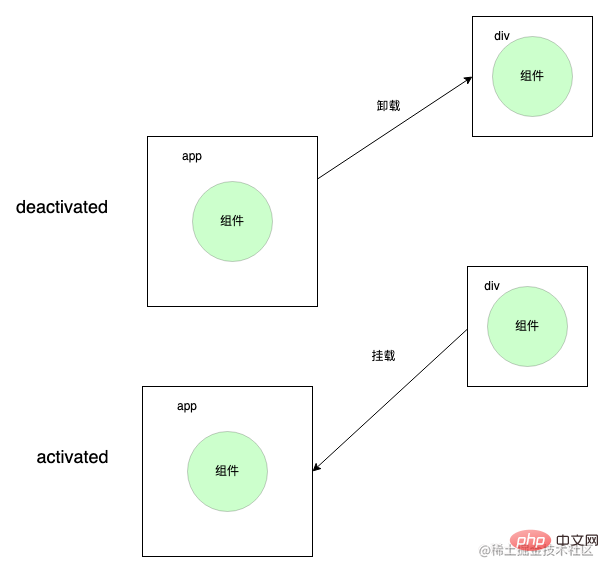
まず、コンポーネントのマウント プロセスを簡単に理解しましょう
KeepAlive 固有のレンダリング ロジックの 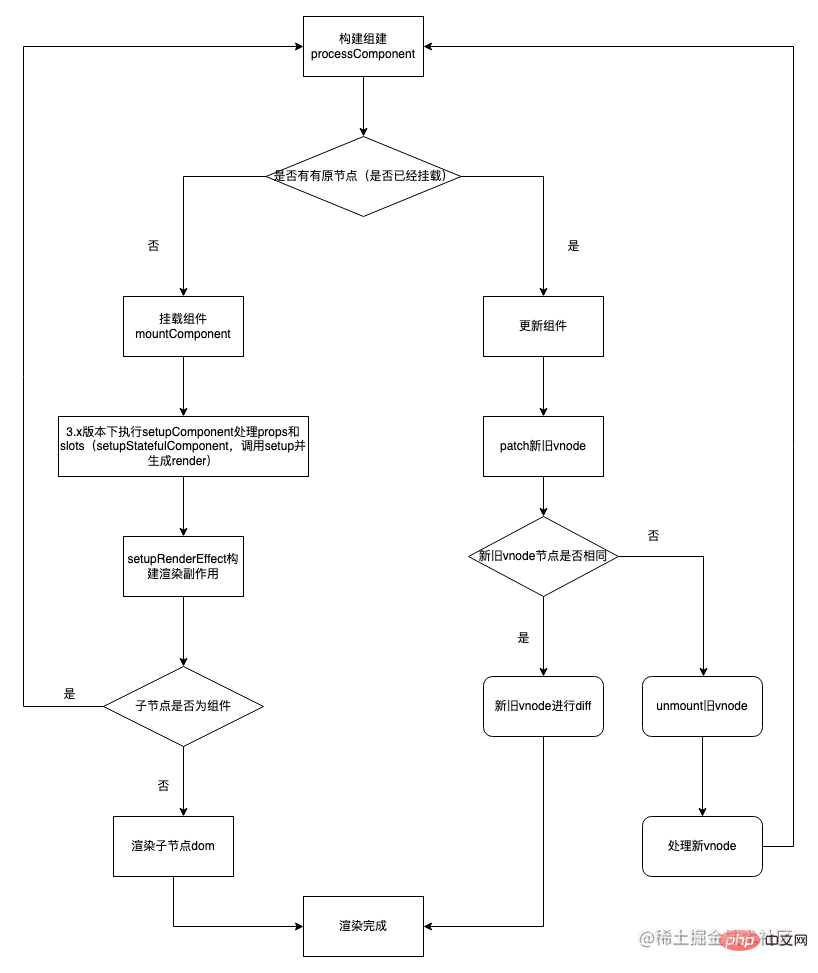 サブコンポーネントは、マウントおよびアンマウント中に実行されるため、マウントおよび破棄ロジックは実行されません。
サブコンポーネントは、マウントおよびアンマウント中に実行されるため、マウントおよび破棄ロジックは実行されません。
- KeepAlive コンポーネントのプロパティ
const KeepAliveImpl: ComponentOptions = { name: "KeepAlive", // 标识这是一个 KeepAlive 组件 __isKeepAlive: true, // props props: { exclude: [String, Array, RegExp], include: [String, Array, RegExp], max: [String, Number] } } // isKeepAlive export const isKeepAlive = (vnode: VNode): boolean => (vnode.type as any).__isKeepAliveログイン後にコピー
// setup 接着上面的代码 // 获取到当前 KeepAlive 组件实例 const instance = getCurrentInstance()! as any; // 拿到 ctx const sharedContext = instance.ctx as KeepAliveContext; // cache 缓存 // key: vnode.key | vnode.type value: vnode const cache: Cache = new Map() // 需要拿到某些的 renderer 操作函数,需要自己特定执行渲染和卸载逻辑 const { renderer: { p: patch, m: move, um: _unmount, o: { createElement } } } = sharedContext // 隐藏的容器,用来存储需要隐藏的 dom const storeageContainer = createElement('div') // 存储当前的子组件的缓存 key let pendingKey: CacheKey | null = null sharedContext.activate = (vnode, container, anchor) => { // KeepAlive 下组件激活时执行的 move 逻辑 move(vnode, container, anchor, 0 /* ENTER */) } sharedContext.deactivate = (vnode) => { // KeepAlive 下组件失活时执行的 move 逻辑 move(vnode, storeageContainer, null, 1 /* LEAVE */) } return () => { // 没有子组件 if (!slots.default) { return null; } const children = slots.default() as VNode[]; const rawNode = children[0]; let vnode = rawNode; const comp = vnode.type as ConcreteComponent; const name = comp.displayName || comp.name const { include, exclude } = props; // 没有命中的情况 if ( (include && (!name || !matches(include, name))) || (exclude && name && matches(exclude, name)) ) { // 直接渲染子组件 return rawNode; } // 获取子组件的 vnode key const key = vnode.key == null ? comp : vnode.key; // 获取子组件缓存的 vnode const cachedVNode = cache.get(key); pendingKey = key; // 命中缓存 if (cachedVNode) { vnode.el = cachedVNode.el; // 继承组件实例 vnode.component = cachedVNode.component; // 在 vnode 上更新 shapeFlag,标记为 COMPONENT_KEPT_ALIVE 属性,防止渲染器重新挂载 vnode.shapeFlag |= ShapeFlags.COMPONENT_KEPT_ALIVE } else { // 没命中将其缓存 cache.set(pendingKey, vnode) } // 在 vnode 上更新 shapeFlag,标记为 COMPONENT_SHOULD_KEEP_ALIVE 属性,防止渲染器将组件卸载了 vnode.shapeFlag |= ShapeFlags.COMPONENT_SHOULD_KEEP_ALIVE // 渲染组件 vnode return vnode; }ログイン後にコピー
##KeepAlive コンポーネントでは、sharedContext 上のレンダラーから取得されます。 move、createElement など。
function mountComponent() { // ... if (isKeepAlive(initialVNode)) { ;(instance.ctx as KeepAliveContext).renderer = internals } }ログイン後にコピー
サブコンポーネントは特定の破棄およびレンダリング ロジックを実行します
まず、ご覧のとおり、上記の
KeepAlive コンポーネントをレンダリングするとき、対応するshapeFlag フラグがサブコンポーネントの vnode に追加されます。コンポーネントはマウントされていますが、これにはマウントが必要ありません。特別な処理が必要です
const processComponent = (
n1: VNode | null,
n2: VNode,
container: RendererElement,
anchor: RendererNode | null,
) => {
if (n1 == null) {
// 在 KeepAlive 组件渲染时会对子组件增加 COMPONENT_KEPT_ALIVE 标志
// 挂载子组件时会判断是否 COMPONENT_KEPT_ALIVE ,如果是不会调用 mountComponent 而是直接执行 activate 方法
if (n2.shapeFlag & ShapeFlags.COMPONENT_KEPT_ALIVE) {
;(parentComponent!.ctx as KeepAliveContext).activate(
n2,
container,
anchor
)
}
// ...
}
}COMPONENT_SHOULD_KEEP_ALIVEフラグは、コンポーネントがアンマウントされるときに、アンマウントが必要ではないことをレンダラーに伝えるためにも使用されます。特殊な加工が必要となります。
const unmount: UnmountFn = (vnode) => {
// ...
// 在 KeepAlive 组件渲染时会对子组件增加 COMPONENT_SHOULD_KEEP_ALIVE 标志
// 然后在子组件卸载时并不会真实的卸载而是调用 KeepAlive 的 deactivate 方法
if (shapeFlag & ShapeFlags.COMPONENT_SHOULD_KEEP_ALIVE) {
;(parentComponent!.ctx as KeepAliveContext).deactivate(vnode)
return
}
}activated
deactivated ライフ サイクルをマウントする方法 (ライフ サイクル関連のものに注目する必要はありません)
- まず、これら 2 つのライフ サイクルは KeepAlive コンポーネント内で一意に宣言され、使用するために直接エクスポートされます。
export function onActivated( hook: Function, target?: ComponentInternalInstance | null ) { // 注册 activated 的回调函数到当前的 instance 的钩子函数上 registerKeepAliveHook(hook, LifecycleHooks.ACTIVATED, target) } export function onDeactivated( hook: Function, target?: ComponentInternalInstance | null ) { // 注册 deactivated 的回调函数到当前的 instance 的钩子函数上 registerKeepAliveHook(hook, LifecycleHooks.DEACTIVATED, target) }ログイン後にコピー然后因为这两个生命周期会注册在 setup 里面,所以只要执行 setup 就会将两个生命周期的回调函数注册到当前的 instance 实例上
// renderer.ts // mount 函数逻辑 const mountComponent = (initialVNode, container, anchor, parentComponent, parentSuspense, isSVG, optimized ) => { // ... const instance: ComponentInternalInstance = compatMountInstance || (initialVNode.component = createComponentInstance( initialVNode, parentComponent, parentSuspense )) // 执行 setup setupComponent(instance) } // setupcomponent 处理 setup 函数值 export function setupComponent( instance: ComponentInternalInstance, isSSR = false ) { // ... const isStateful = isStatefulComponent(instance) // ... const setupResult = isStateful // setupStatefulComponent 函数主要功能是设置当前的 instance ? setupStatefulComponent(instance, isSSR) : undefined // ... } function setupStatefulComponent( instance: ComponentInternalInstance ){ if (setup) { //设置当前实例 setCurrentInstance(instance) // 执行组件内 setup 函数,执行 onActivated 钩子函数进行回调函数收集 const setupResult = callWithErrorHandling( setup, instance, ErrorCodes.SETUP_FUNCTION, [__DEV__ ? shallowReadonly(instance.props) : instance.props, setupContext] ) // currentInstance = null; unsetCurrentInstance() } }ログイン後にコピー最后在执行
sharedContext.activate和sharedContext.deactivate的时候将注册在实例上的回调函数取出来直接执行就OK了,执行时机在 postRender 之后sharedContext.activate = (vnode, container, anchor) => { // KeepAlive 下组件激活时执行的 move 逻辑 move(vnode, container, anchor, 0 /* ENTER */) // 把回调推入到 postFlush 的异步任务队列中去执行 queuePostRenderEffect(() => { if (instance.a) { // a是 activated 钩子的简称 invokeArrayFns(instance.a) } }) } sharedContext.activate = (vnode, container, anchor) => { // KeepAlive 下组件失活时执行的 move 逻辑 move(vnode, container, anchor, 0 /* ENTER */) queuePostRenderEffect(() => { if (instance.da) { // da是 deactivated 钩子的简称 invokeArrayFns(instance.da) } }) } export const enum LifecycleHooks { // ... 其他生命周期声明 DEACTIVATED = 'da', ACTIVATED = 'a', } export interface ComponentInternalInstance { // ... 其他生命周期 [LifecycleHooks.ACTIVATED]: Function[] [LifecycleHooks.DEACTIVATED]: Function[] }ログイン後にコピー以下是关于上述demo如何实现的简化流程图

需要注意的知识点
1、什么时候缓存
KeepAlive 组件的
onMounted和onUpdated生命周期时进行缓存2、什么时候取消缓存
缓存数量超过设置的 max 时
- 监听 include 和 exclude 修改的时候,会读取缓存中的知进行判断是否需要清除缓存
修剪缓存的时候也要 unmount(如果该缓存不是当前组件)或者 resetShapeFlag 将标志为从 KeepAlive 相关 shapeFlag 状态重置为 STATEFUL_COMPONENT 状态(如果该缓存是当前组件,但是被exclude了),当然 unmount 函数内包含 resetShapeFlag 操作
3、缓存策略
KeepAlive 组件的缓存策略是 LRU(last recently used)缓存策略
核心思想在于需要把当前访问或渲染的组件作为最新一次渲染的组件,并且该组件在缓存修剪过程中始终是安全的,即不会被修剪。
看下面的图更加直观,图片来源一篇讲keepAlive 缓存优化的文章

4、如何添加到 vue devtools 组件树上
sharedContext.activate = (vnode, container, anchor) => { // instance 是子组件实例 const instance = vnode.component! // ... // dev环境下设置, 自己模拟写的 devtools.emit('component:added', instance.appContext.app, instance.uid, instance.parent ? instance.parent.uid: undefined, instance) // 官方添加 if (__DEV__ || __FEATURE_PROD_DEVTOOLS__) { // Update components tree devtoolsComponentAdded(instance) } } // 同理 sharedContext.deactivates 上也要添加,不然不会显示在组件树上ログイン後にコピー5、缓存的子组件 props 更新处理
当子组件有 prop 更新时是需要重新去 patch 的,所以在 activate 的时候需要重新执行 patch 进行子组件更新
sharedContext.activate = (vnode, container, anchor) => { // ... // props 改变需要重新 patch(update) patch( instance.vnode, vnode, container, anchor, instance, parentSuspense, isSVG, vnode.slotScopeIds, optimized ) }ログイン後にコピー以上がVue の KeepAlive コンポーネントについて説明する記事の詳細内容です。詳細については、PHP 中国語 Web サイトの他の関連記事を参照してください。

ホットAIツール

Undresser.AI Undress
リアルなヌード写真を作成する AI 搭載アプリ

AI Clothes Remover
写真から衣服を削除するオンライン AI ツール。

Undress AI Tool
脱衣画像を無料で

Clothoff.io
AI衣類リムーバー

AI Hentai Generator
AIヘンタイを無料で生成します。

人気の記事

ホットツール

メモ帳++7.3.1
使いやすく無料のコードエディター

SublimeText3 中国語版
中国語版、とても使いやすい

ゼンドスタジオ 13.0.1
強力な PHP 統合開発環境

ドリームウィーバー CS6
ビジュアル Web 開発ツール

SublimeText3 Mac版
神レベルのコード編集ソフト(SublimeText3)

ホットトピック
 7492
7492
 15
15
 1377
1377
 52
52
 77
77
 11
11
 19
19
 41
41
 PHP と Vue: フロントエンド開発ツールの完璧な組み合わせ
Mar 16, 2024 pm 12:09 PM
PHP と Vue: フロントエンド開発ツールの完璧な組み合わせ
Mar 16, 2024 pm 12:09 PM
PHP と Vue: フロントエンド開発ツールの完璧な組み合わせ 今日のインターネットの急速な発展の時代において、フロントエンド開発はますます重要になっています。 Web サイトやアプリケーションのエクスペリエンスに対するユーザーの要求がますます高まっているため、フロントエンド開発者は、より効率的で柔軟なツールを使用して、応答性の高いインタラクティブなインターフェイスを作成する必要があります。フロントエンド開発の分野における 2 つの重要なテクノロジーである PHP と Vue.js は、組み合わせることで完璧なツールと見なされます。この記事では、PHP と Vue の組み合わせと、読者がこれら 2 つをよりよく理解し、適用できるようにするための詳細なコード例について説明します。
 フロントエンドの面接官からよく聞かれる質問
Mar 19, 2024 pm 02:24 PM
フロントエンドの面接官からよく聞かれる質問
Mar 19, 2024 pm 02:24 PM
フロントエンド開発のインタビューでは、HTML/CSS の基本、JavaScript の基本、フレームワークとライブラリ、プロジェクトの経験、アルゴリズムとデータ構造、パフォーマンスの最適化、クロスドメイン リクエスト、フロントエンド エンジニアリング、デザインパターン、新しいテクノロジーとトレンド。面接官の質問は、候補者の技術スキル、プロジェクトの経験、業界のトレンドの理解を評価するように設計されています。したがって、候補者はこれらの分野で自分の能力と専門知識を証明するために十分な準備をしておく必要があります。
 Django はフロントエンドですか、バックエンドですか?それをチェックしてください!
Jan 19, 2024 am 08:37 AM
Django はフロントエンドですか、バックエンドですか?それをチェックしてください!
Jan 19, 2024 am 08:37 AM
Django は、迅速な開発とクリーンなメソッドを重視した Python で書かれた Web アプリケーション フレームワークです。 Django は Web フレームワークですが、Django がフロントエンドなのかバックエンドなのかという質問に答えるには、フロントエンドとバックエンドの概念を深く理解する必要があります。フロントエンドはユーザーが直接対話するインターフェイスを指し、バックエンドはサーバー側プログラムを指し、HTTP プロトコルを通じてデータと対話します。フロントエンドとバックエンドが分離されている場合、フロントエンドとバックエンドのプログラムをそれぞれ独立して開発して、ビジネス ロジックとインタラクティブ効果、およびデータ交換を実装できます。
 C# 開発経験の共有: フロントエンドとバックエンドの共同開発スキル
Nov 23, 2023 am 10:13 AM
C# 開発経験の共有: フロントエンドとバックエンドの共同開発スキル
Nov 23, 2023 am 10:13 AM
C# 開発者としての私たちの開発作業には、通常、フロントエンドとバックエンドの開発が含まれますが、テクノロジーが発展し、プロジェクトが複雑になるにつれて、フロントエンドとバックエンドの共同開発はますます重要かつ複雑になってきています。この記事では、C# 開発者が開発作業をより効率的に完了できるようにする、フロントエンドとバックエンドの共同開発テクニックをいくつか紹介します。インターフェイスの仕様を決定した後、フロントエンドとバックエンドの共同開発は API インターフェイスの相互作用から切り離せません。フロントエンドとバックエンドの共同開発をスムーズに進めるためには、適切なインターフェース仕様を定義することが最も重要です。インターフェイスの仕様にはインターフェイスの名前が含まれます
 Go 言語のフロントエンド テクノロジーの探求: フロントエンド開発の新しいビジョン
Mar 28, 2024 pm 01:06 PM
Go 言語のフロントエンド テクノロジーの探求: フロントエンド開発の新しいビジョン
Mar 28, 2024 pm 01:06 PM
Go 言語は、高速で効率的なプログラミング言語として、バックエンド開発の分野で広く普及しています。ただし、Go 言語をフロントエンド開発と結びつける人はほとんどいません。実際、フロントエンド開発に Go 言語を使用すると、効率が向上するだけでなく、開発者に新たな視野をもたらすことができます。この記事では、フロントエンド開発に Go 言語を使用する可能性を探り、読者がこの分野をよりよく理解できるように具体的なコード例を示します。従来のフロントエンド開発では、ユーザー インターフェイスの構築に JavaScript、HTML、CSS がよく使用されます。
 フロントエンドにインスタントメッセージングを実装する方法
Oct 09, 2023 pm 02:47 PM
フロントエンドにインスタントメッセージングを実装する方法
Oct 09, 2023 pm 02:47 PM
インスタント メッセージングを実装する方法には、WebSocket、ロング ポーリング、サーバー送信イベント、WebRTC などが含まれます。詳細な紹介: 1. クライアントとサーバーの間に永続的な接続を確立してリアルタイムの双方向通信を実現できる WebSocket フロントエンドは WebSocket API を使用して WebSocket 接続を作成し、送受信によるインスタント メッセージングを実現できます。 2. Long Polling(リアルタイム通信を模擬する技術)など
 Golang とフロントエンド テクノロジーの組み合わせ: Golang がフロントエンド分野でどのような役割を果たすかを探る
Mar 19, 2024 pm 06:15 PM
Golang とフロントエンド テクノロジーの組み合わせ: Golang がフロントエンド分野でどのような役割を果たすかを探る
Mar 19, 2024 pm 06:15 PM
Golang とフロントエンド テクノロジーの組み合わせ: Golang がフロントエンド分野でどのような役割を果たしているかを調べるには、具体的なコード例が必要です。インターネットとモバイル アプリケーションの急速な発展に伴い、フロントエンド テクノロジーの重要性がますます高まっています。この分野では、強力なバックエンド プログラミング言語としての Golang も重要な役割を果たします。この記事では、Golang がどのようにフロントエンド テクノロジーと組み合わされるかを検討し、具体的なコード例を通じてフロントエンド分野での可能性を実証します。フロントエンド分野における Golang の役割は、効率的で簡潔かつ学びやすいものとしてです。
 Django: フロントエンド開発とバックエンド開発の両方を処理できる魔法のフレームワークです。
Jan 19, 2024 am 08:52 AM
Django: フロントエンド開発とバックエンド開発の両方を処理できる魔法のフレームワークです。
Jan 19, 2024 am 08:52 AM
Django: フロントエンド開発とバックエンド開発の両方を処理できる魔法のフレームワークです。 Django は、効率的でスケーラブルな Web アプリケーション フレームワークです。 MVCやMTVなど複数のWeb開発モデルをサポートし、高品質なWebアプリケーションを簡単に開発できます。 Django はバックエンド開発をサポートするだけでなく、フロントエンド インターフェイスを迅速に構築し、テンプレート言語を通じて柔軟なビュー表示を実現します。 Django はフロントエンド開発とバックエンド開発をシームレスに統合するため、開発者は学習に特化する必要がありません。




